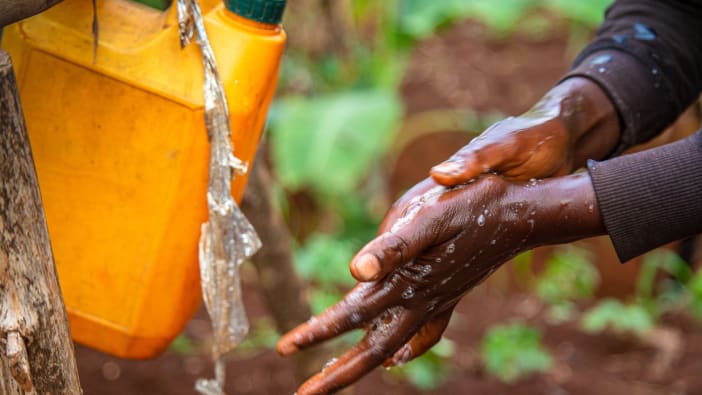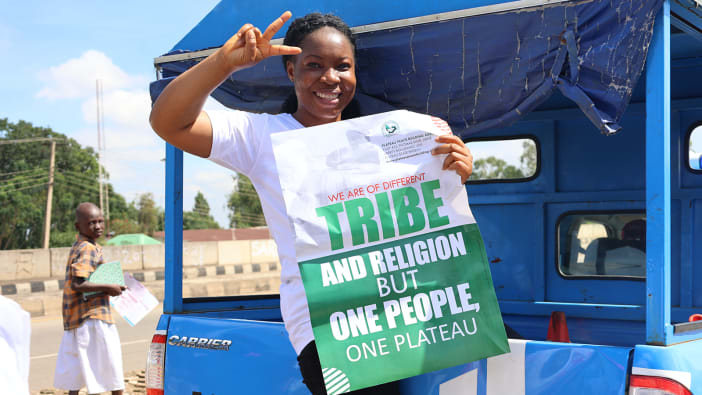by Malcolm P Chisholm

Walls of separation
People often talk about peace and reconciliation, but few actually walk the costly road of breaking down these walls of separation
2006

From: Forgiveness and reconciliation – Footsteps 68
How to support each other to restore broken relationships

Photo: Penny Relph
Physical distances between people and cultures can now be crossed by aeroplanes, mobile phones and 24-hour television news coverage. But many communities around the world are still divided. Conflict may be open or unseen. Physical or emotional walls now separate people who used to live together in peace. People often talk about peace and reconciliation, but few actually walk the costly road of breaking down these walls of separation.
Walls are built for many different reasons, such as to support buildings, to define a legal boundary, to protect people or property, and to keep animals from wandering and make looking after them easier. In many parts of the world, walls are also built within and between communities. Some of these are physical walls, such as the long ‘peace walls’ within certain parts of Belfast, in Northern Ireland. There has been violent conflict in this area for many years. These walls are a representation of the genuine fear and mistrust held between opposing communities who live side by side. Some of these walls are several miles long. Over the years, as the conflict continued, they have been built higher and stronger. Even after official government peace agreements, the walls have continued to grow.
These ‘peace walls’ are a reminder that while governments may say that peace has arrived, life at ground level is not one of peaceful harmony. Around the world, many local communities are left behind to struggle in former ethnic conflict zones as the world moves on to the next peace initiative. Walls across communities cause long diversions to previously simple journeys. Sadly, with time, people get used to them and it becomes normal. Other people, who were not directly involved or around at the time of the original need for the walls, accept such walls and the necessary diversions. Yet in their hearts they know that something is not right.
Unseen walls can also be built in people’s hearts, such as between a man and wife, between former friends, or between ‘them’ and ‘us’. They can be symbolic of a relationship that now rests on mistrust, rather than being built on trust. Each misinterpreted action or inaction adds another brick in the wall. These divisions can also be found within the Christian church, which should be working towards unity and peace in a divided and hurting world. We pray and urge local politicians to get together to sort out a political situation. Yet many Christians are not prepared to recognise or deal with the walls that cause so much division within the church. Often the walls we put up affect not only our lives but the lives of others as well.
Just as people have to take avoidance routes around physical walls, so many people also avoid meeting the people they are in conflict with. Much energy, time and money is used up in maintaining these walls, but the underlying reasons for the existence of such walls is not addressed. Unfortunately, walls do not come down by themselves. People must want them to come down. Underlying fears and attitudes must be faced and dealt with, and the process takes time, courage and mutual agreement. The group exercise below can be used to demonstrate how walls are built between people.
Recognising a wall is one thing. Taking the costly steps to start demolishing that wall is not easy, but the rewards outweigh the cost. Laying down our pride, forgiving people and dealing with conflict is not an easy task. Even if we feel we are not in the wrong, perhaps we need to be the one to make the first step towards reconciliation. Several trips across the rubble of the wall will have to be taken. Reconciliation is an integral part of God’s work, and is not optional for Christians. Jesus knocked down the wall separating us from God. With his grace, and with the help of the Holy Spirit, we can also creatively help others to be reconciled.
Malcolm P Chisholm is an independent consultant working for over 20 years in the field of reconciliation and peace building.
13 Dundela Gardens
Belfast
Country Antrim
BT4 3DH
Northern Ireland
UK
Email: [email protected]
Building walls
This group activity can be used within the context of a peace-building workshop or as part of ongoing reconciliation work within a community in conflict. The exercise can effectively demonstrate how walls get built up between groups of people, reveal issues of conflict that need to be dealt with, and introduce ideas of reconciliation. An experienced facilitator is needed as it is important to discuss and work through the issues that may be raised during the exercise. For more information about facilitation see Footsteps 60.
1. Getting started
For this activity you will need:
Venue Preferably indoors, or an outdoor space with clearly marked sides.
Groups Divide the participants into two groups. Choose the groups randomly (for example by numbering participants alternately 1, 2, 1, 2, 1, 2 etc), so that each group contains a mix of people from both sides of the actual conflict. The two groups move to different ends of the room.
Equipment Old cardboard boxes (empty tin cans, logs, or bricks could also be used), small pieces of paper to stick on the boxes, pens.
Time Allow about 1½ – 2 hours, including at least ½ hour for feedback.
2. Wall-building for beginners
One person starts by writing or drawing on a small piece of paper something that he or she does not like about the ‘other group’ or ‘other person’ in their conflict situation. This could be an attitude or an action, something they have experienced personally. It should then be fixed onto the side of a box. This box is then placed in between the two groups, as the first brick in the wall. The piece of paper should be on the writer’s side of the wall, so that the other group doesn’t see it. Someone from the other group then does the same from their side and adds it to the wall. Neither group has the opportunity to know what is written on the pieces of paper on the other side.
Soon the wall of boxes begins to grow, and so does the participants’ enthusiasm! Continue building until it is as high as they can safely build it. It is important that every participant adds at least one or two boxes of their own to the wall. Once the wall is built, ask the participants to shout out some of their collective feelings about the ‘other side’. After a while ask them what they want to do with the wall. Hopefully, they want it knocked down. If this is so, let them do so carefully. Usually this is very quick!
3. Debriefing
Once the wall is knocked down and all the rubble cleared away, it is important to debrief the participants. Ask the participants to feed back about what their team wrote on their bits of paper (to make this anonymous, people do not have to say what was on their specific one). The facilitator should summarise these on a large piece of paper. Then, ask the participants to feed back about how they felt about themselves when placing the boxes, and then how they felt about the other group, as the wall got higher and they were cut off from them.
Throughout this activity, the facilitator needs to be very careful to notice any signs of painful emotions, or body language that reveals exposed hurts, and to manage any sensitive situations that may arise. It is important to give people the chance to express what they feel and think and not just to suppress it. However, it is also important that tensions do not go too far and become unmanageable and destructive. One idea is to have a suggestion box, where people can write down issues they would like to be raised but perhaps find too emotionally hurtful to speak about. These issues can then be looked at constructively later in the workshop.
At the end of the feedback, the facilitator can draw out common areas for future discussions or personal reflection and action by the participants. They should discuss how to take the learning from this exercise forward into their wider situation and community.
Similarly Tagged Content
Share this resource
If you found this resource useful, please share it with others so they can benefit too.

Subscribe to Footsteps magazine
A free digital and print magazine for community development workers. Covering a diverse range of topics, it is published three times a year.
Sign up now - Subscribe to Footsteps magazine




